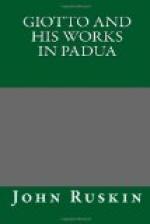None of the compositions display more clearly this typical and reflective character than that of the Raising of Lazarus. Later designers dwell on vulgar conditions of wonder or horror, such as they could conceive likely to attend the resuscitation of a corpse; but with Giotto the physical reanimation is the type of a spiritual one, and, though shown to be miraculous, is yet in all its deeper aspects unperturbed, and calm in awfulness. It is also visibly gradual. “His face was bound about with a napkin.” The nearest Apostle has withdrawn the covering from the face, and looks for the command which shall restore it from wasted corruption, and sealed blindness, to living power and light.
Nor is it, I believe, without meaning, that the two Apostles, if indeed they are intended for Apostles, who stand at Lazarus’ side, wear a different dress from those who follow Christ. I suppose them to be intended for images of the Christian and Jewish Churches in their ministration to the dead soul: the one removing its bonds, but looking to Christ for the word and power of life; the other inactive and helpless—the veil upon its face—in dread; while the principal figure fulfils the order it receives in fearless simplicity.
* * * * *
XXV.
THE ENTRY INTO JERUSALEM.
This design suffers much from loss of colour in translation. Its decorative effect depends on the deep blue ground, relieving the delicate foliage and the local colours of dresses and architecture. It is also one of those which are most directly opposed to modern feeling: the sympathy of the spectator with the passion of the crowd being somewhat rudely checked by the grotesque action of two of the foremost figures. We ought, however, rather to envy the deep seriousness which could not be moved from dwelling on the real power of the scene by any ungracefulness or familiarity of circumstance. Among men whose minds are rightly toned, nothing is ludicrous: it must, if an act, be either right or wrong, noble or base; if a thing seen, it must either be ugly or beautiful: and what is either wrong or deformed is not, among noble persons, in anywise subject for laughter; but, in the precise degree of its wrongness or deformity, a subject of horror. All perception of what, in the modern European mind, falls under the general head of the ludicrous, is either childish or profane; often healthy, as indicative of vigorous animal life, but always degraded in its relation to manly conditions of thought. It has a secondary use in its power of detecting vulgar imposture; but it only obtains this power by denying the highest truths.




